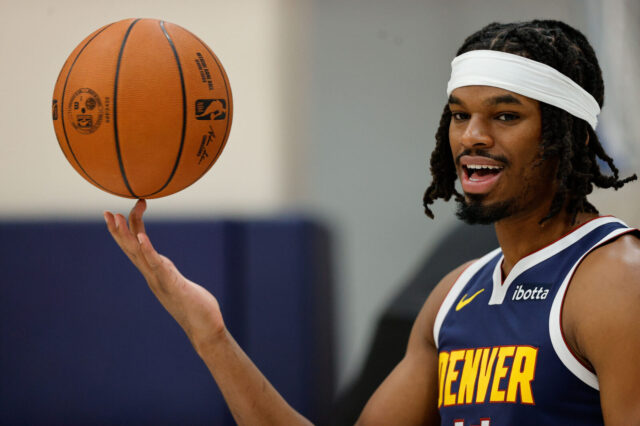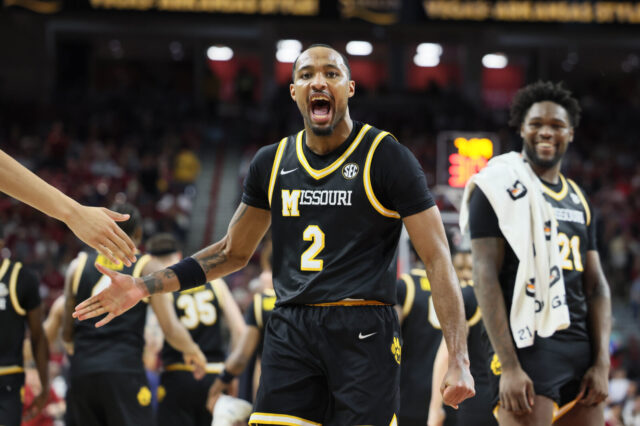It’s early, but P.J. Dozier is still finding his way within the Denver Nuggets rotation this season.
After a strong 2020-21 season that was cut short prematurely by injury, the expectations were high for Dozier to perform better than ever in 2021-22. In a contract year, Dozier is fighting for his next deal, be it with the Nuggets or with someone else. Showcasing his versatile skill set, excelling for a championship contender, and helping the Nuggets win games had to be at the top of the priority list for the 25-year-old versatile wing from South Carolina.
And yet, perhaps no Nugget has been placed in a more difficult position (outside of maybe Nikola Jokić) to start the year.
To get started, here are Dozier’s per-game statistics in the 2020-21 season versus the 2021-22 season:
| Year | Minutes | Points | Rebounds | Assists | 2-point % | 3-point % | Free Throw % | Plus-Minus |
|---|---|---|---|---|---|---|---|---|
| 2020-21 | 21.8 | 7.7 | 3.6 | 1.8 | 49.0 | 31.5 | 63.6 | +3.9 |
| 2021-22 | 19.8 | 5.6 | 3.6 | 1.6 | 40.8 | 31.9 | 76.9 | -5.2 |
Individually, Dozier hasn’t had the same level of impact that he did in the 2020-21 season. The box score numbers are relatively similar, but Dozier is struggling to score with the same level of efficiency inside the arc. Dozier’s pick and roll efficiency has tanked with him scoring just 0.44 points per possession on pick and rolls this season, somehow just the third worst mark on the team ahead of Austin Rivers (0.40 ppp) and Aaron Gordon (0.36 ppp). Facu Campazzo isn’t far ahead either (0.47 ppp).
More on the idea of reduced talent around Dozier later.
The Nuggets often run the above play with the intent to generate a lob pass to the rolling big man. Dozier generally runs it well too, and his timing generally creates an opportunity for JaMychal Green, Aaron Gordon, and other potential partners. This time though, Dozier is crowded by the strong side helpers off Campazzo and Barton, pushing him closer to the rim protector in Tony Bradley. Rather than settle for the midrange pull-up he usually goes to in these situations, Dozier went to an awkward floater that had no chance of going in (Dozier airballed another floater in this game in the second half). The shot quality value on that possession was fairly low, and it’s no surprise the Bulls were in position to secure the rebound either with Dozier not really forcing the defense to commit to his drive.
On the season so far, Dozier is shooting just 14.3% from the field on shots between three and ten feet. He’s shooting 75% on shots attempted between zero and three feet away from the rim. Dozier has done well when he’s in attack mode this season rather than settling for shots in uncomfortable places. In fact, he shoots a higher career three-point percentage (32%) than he does on shots in the floater zone of three to ten feet (30.1%). Either he has to improve on those shots or cut them out of his diet entirely. Using his handle and footwork generally make for better shots.
It’s also clear that Dozier is struggling in the pick and roll without the gravity of shooters around him and a rim roller to utilize consistently. The Nuggets are making due with JaMychal Green for the latter, but the former involves relying upon lineups featuring Jeff Green (20%), JaMychal Green (22.2%), Facu Campazzo (34.1% and trending up), Austin Rivers (27.8%), and Bones Hyland (31.7%). There are no deadeye shooters for Dozier to hit for passes (or use to create more space) and JaMychal Green, while a hard worker on the roll, is just 6’8” when the roller needs to be a few inches taller and more springy in general.
We also haven’t seen many connections between Jokić and Dozier this year, which is too bad because they often connect for some nice possessions in the pick and roll.
Dozier has played 214 out of his 337 total minutes without Jokić on the floor, one of the highest proportions of any Nugget this season. In the minutes when they share the floor, the Nuggets post a +3.2 net rating. In the minutes with just Dozier, it’s a -21.1 net rating. That number is so large that it becomes difficult to take any of the numbers seriously. The formula clearly isn’t working when Jokić rests, but it seems difficult to blame the problem entirely on Dozier, Campazzo, the Greens, or anyone on the bench frankly.
Much of the issues facing that entire group are by design. Without Jamal Murray in the fold and with Michael Porter Jr. facing a potentially early exit this season, Dozier has shared the floor with weaker lineups overall that make little sense. There hasn’t been enough staggering to make up for the bad fit, and the Nuggets have hemorrhaged points as a result while Jokić is off the floor.
Three-Man lineup combinations featuring Dozier (+/-)
2020-21 (last year)
- Dozier – Campazzo – JaMychal Green: +84 in 331 minutes
- Dozier – Jokić – Porter: +88 in 306 minutes
- Dozier – Campazzo – Jokić: +15 in 270 minutes
- Dozier – Campazzo – Porter: +47 in 248 minutes
- Dozier – Barton – Jokić: +44 in 238 minutes
2021-22 (this year)
- Dozier – Campazzo – Jeff Green: -76 in 108 minutes
- Dozier – Campazzo – JaMychal Green: -81 in 108 minutes
- Dozier – Bones – JaMychal Green: -41 in 84 minutes
- Dozier – Jokić – Gordon: +17 in 83 minutes
- Dozier – Campazzo – Rivers: -72 in 78 minutes
The differences from year to year are staggering. Three of Dozier’s five most popular lineups in 2020-21 included Jokić. One other included Porter. The top lineup, the only overlapping lineup between seasons, was highly successful on both ends of the floor with Monte Morris and Jamal Murray, the two players most commonly on the floor with that particular trio. In 2021-22, Murray has obviously spent no time with that trio, and Morris has spent just six minutes since he’s now the starting point guard. The most common configurations feature Jeff Green, Austin Rivers, Bones Hyland, and Will Barton, which just isn’t enough offense to survive on most nights.
In addition, the absences of Porter and Jokić have forced Dozier into an extremely uncomfortable lineup configuration featuring Dozier at power forward next to JaMychal Green, Jeff Green, or Aaron Gordon. Denver has been guard heavy this year with the Porter/Jokić injuries, but also with injuries to Vlatko Čančar and Zeke Nnaji. Rather than go to Bol Bol in an attempt to restore positional balance off the bench, the Nuggets have often played all three of Campazzo, Bones, and Rivers together. When Bones was forced to sit with an ankle injury, it was Morris or Barton staggering minutes with the second unit. These lineup decisions have pushed Dozier to the power forward spot where his positional size has become a necessity at the 3 or 4 rather than a luxury at the 1 or 2. 25% of Dozier’s minutes have been played at power forward, according to Basketball Reference. Another 59% have been played at small forward.
It’s pretty clear that Dozier has taken a small step back defensively as well, though those possessions are harder to identify within the grand scheme of Denver’s defensive issues. Rather than mistakes Dozier is making, possessions where his man gets points or assists frequently look like this one: pretty solid defensive positioning and activity.
Denver’s lack of a rim protector has made the front of the rim a hot spot for opposing teams, and while Dozier can do all of the work he can at small forward or power forward, he just isn’t going to be able to contest most seven footers. Opposing teams go right around Denver’s perimeter defense in the backcourt and right over the top of Denver’s interior defense at the big man spots. It’s hard to point at anyone in particular when so many of the possessions are a mess to begin with.
This miscue by Jeff Green below is a pretty clear example as well. The Nuggets are clearly playing blitz and recover on defense, and while Dozier uses proper technique against JaVale McGee, he doesn’t expect Cam Payne to walk into an uncontested three because Green hasn’t left the elbow.
All of this to say: I have no idea how to evaluate Dozier within the context of Denver’s bad bench group. He’s meant to lead the unit as the sixth man, standing out with his defense, playmaking, and versatility. He hasn’t really stood out in any way, shape, or form to this point in the season. If anything, he has regressed, but it’s still early.
How much of his struggles can be attributed to rarely sharing the court with Jokić? With Porter? With Murray? Last season, lineups featuring the quartet of Dozier, Jokić, Murray, and Porter generated a +41.4 net rating in 42 minutes. Lineups with Dozier but without the three stars were also good, but they almost exclusively featured some combination of Will Barton, Monte Morris, JaMychal Green, and Isaiah Hartenstein, a much more functional pick and roll setup where Dozier didn’t have to play power forward.
Until we see Dozier in a normal setting on Denver’s bench rather than playing the hero in smaller configurations, it may be impossible to tell whether Dozier is still ready to succeed in Denver’s playoff rotation as the connective wing they need.
Still, it’s important to monitor the situation. The Nuggets need better production and efficiency on both sides of the ball, and Dozier isn’t giving Denver enough on either end right now to make a tangible impact. Could Dozier’s spot be better utilized by Zeke Nnaji or Vlatko Čančar when they return? Could Dozier move into the starting unit rather than Jeff Green to play more exclusively with Nikola Jokić? Could the Nuggets look to make a trade?
All scenarios could be on the table if the bench can’t bounce back.


